Brian Barry O.A.M.
Brian Joseph Barry Born 15th February 1927
Roseworthy Oenology 1946-7
Brian spent the 1947 vintage with Jack Kilgour at Stonyfell Wines and was Dux of the 1948 graduates.
Commenced at Hamilton Wines in 1948 and worked under Maurice Ou with Syd. Hamilton in charge. Products included table and fortified wines, brandy, whisky and gin, and because of this exposure, Brian applied for the advertised position because it offered experience across the oenology spectrum.
Brian was appointed assistant winemaker at Berri Cooperative Winery and Distillery Ltd and commenced duties in July 1952 reporting to the winemaker Doug Collett.
After the 1956 Vintage, as a reward for Brian's efforts, Doug sent him to the Barossa with a range of dry white samples on a two day tour to some of the wineries..
Visited Orlando where Gunter Prass had commenced making "Barossa Pearl". As it turned out his presentation must have been alright because a couple of weeks later Gunter and Mark Tummel came to the Berri Winery, looked at more wines, had a good talk and so began the long association with G. Gramps and Sons.
Whilst studying Microbiology in first year Oenology with John Fornachon as Lecturer, Brian had the company of Colin Gramp and John Siegelie of Seppelts. This may have helped him on the visit to Orlando. At least he was not a stranger to Colin Gramp.
Sales of bulk table wines increased in 1957 and again in 1958 and a new table wine installation was built which included refrigerated cooling to control fermentation temperatures.
Doug Collett resigned in December 1966 and Brian was appointed winemaker.
There was a 20% increase in table wine for the 1967 vintage and Brian had to make some important decisions. These included two 50,000 gallon stainless steel tanks for the cold fermentation of both white and red wines, another refrigeration unit, three static drainers to increase the efficiency of the air-bag presses, and six hundred oak hogsheads.
The 1968 vintage was 20% greater than 1967 so ten more 50,000 gallon stainless steel tanks were ordered, as well as a four stage MAC press.
Brian married Anne Watt.
Son Judson born in March 1969
1970 Crush was 32,981 tonnes, 16,043 tonnes to table wine. This was a record which stood until the 1980 vintage.
Brian was keen to trial the filtering of white grape juice prior to fermentation. To this end a small diatomaceous earth filter was trialed during the 1971 vintageand proved so successful that a large filter was ordered for the 1972 vintage.
Brian also wanted to increase the dry red quality and ordered 100 German oak hogsheads. With the 15 degree centigrade fermentation of the reds and the German oak improved the quality of red wines.
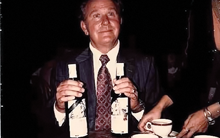 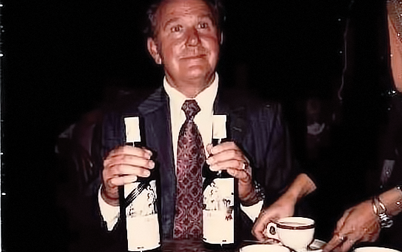 |
In 1973 the Berri Winery Board said Brian could not judge at the Melbourne Wine Show as the Board wanted to enter Berri Wines because they were doing so well in other shows winning Gold and Silver medals. At that time in Melbourne a judge's company could not exhibit. One of the wines that Berri entered was a 1972 Cabernet Sauvignon/Shiraz wine and won the 'Jimmy Watson" trophy.
Karl Nieding is seen here during celebrations in 1973 for winning the trophy.
|
One more highlight was Berri's performance in the first 1975 Canberra Show when the Winery gained most points for gold, silver and bronze medals across the board and so beat all of the big major players such as Lindeman's, Hardy's, Seppelt's, McWilliam's, Penfold's, Gramp's, etc.
What an achievement, which has never received publicity because at the time there was not a trophy for the most successful exhibitor. Not bad for river grapes!!
Another memorable event was the Brandy Bond fire on the 25th February 1974.
When Brian went to Stanley in 1976 he gained a Gold Medal for all the dry wines he made in vintage 1977 and was robbed of the "Jimmy Watson" in 1978 when his Cabernet Sauvignon was clearly better than the Victorian red which a few months after, was gone as a wine. The Stanley Cabernet had by this stage won 4 Gold Medals. Many winemakers told him this on the day.
During this period Brian had planted the Jud's Hill vineyard (named after his son Judson).
Brian left the Stanley Wine Companyy in 1980 and began consulting for various winemakers, including Wolf Blass, Wally Tonkin and Tyrell's Wines which he commenced in 1981 and finished in 1994.
JUDGING
Commenced in 1961 in Adelaide as an Associate.
Chairman was George Fairbrother and Brian was Associate to Max Schubert and John Stanford.
Appointed a Judge at the 1962 Adelaide Wine Show.
Chairman George Fairbrother, Jack Kilgour and John Fornachon.
A Judge at Adelaide from 1962 to 1973.
A Judge at Melbourne Wine Show 1963-1972.
A Judge at Perth Wine Show 1971,1972,1973.
Chairman at Adelaide Wine Show 1974 to 1979.
Chairman at Perth Wine Show 1974-1979.
Inaugural Chairman Canberra National Wine Show in 1976
Chairman there until 1982.
Also judged at Canberra Show several years after 1982.
Chairman in Brisbane in 1977.
Inaugural Chairman of Barossa Valley Wine Show in 1977.
Chairman there until 1990 and again in 1993.
A Judge at the Sydney Wine Show in 1978 and several years afterwards.
Other venues that Brian judged at included the Hunter Valley, S.A. Riverland Wine Show, the Albany Wine Show and the Hyatt Hotel in Adelaide.
Judge at the Inaugural National Riesling Challenge in Canberra in 2000.
Just to sum up Brian’s judging record in one year which was 1977; Brian was Chairman of the Wine Shows at Brisbane, Perth, Adelaide, Canberra, Barossa and S.A. Riverland.
What an accolade for a charismatic, pragmatic and dedicated winemaker. His vintage practice was to follow each wine through to completion and make doubly sure that all wines were kept in the best condition by monitoring each wines development. With 50 years of winemaking and judging and he can still remember the great wines of both his and his fellow Australian Winemakers.
Brian recalls that he was recommended by George Fairbrother to succeed him as Chairman of the Sydney Wine Show, but that was not to be, and was a great disappointment for Brian.
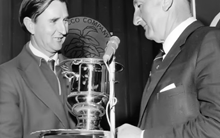 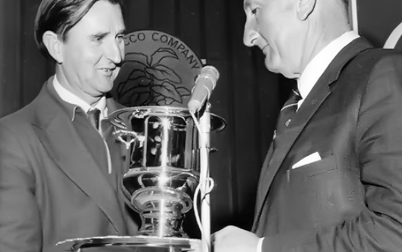 |
Brian Barry O.A.M. |
THE UNSUNG HERO
Little-known Brian Barry has helped
make the Australian wine industry what
it is today.
He's the only winemaker who's produced a Jimmy Watson Trophy winner from
Riverland grapes. He had a lot to do with improving the quality of Tyrrells' wines in
recent years. He consulted to Wolf Blass when Wolf was but a cub.He has a wine
judging record that stands comparison with that of Len Evans. And his vineyard has
provided grapes for Petaluma's famous rieshng.
Yet not many people outside of the wine industry have heard of Brian Barry.This mild
mannered chap is something of an unsung hero.He produces his own range of wines
under the Brian Barry Jud's Hill and Gleeson's Ridge brands, has done an awful lot for
the quality of Australian wines, which in turn helped put this country on the world
wine map and make the export boom possible.
Barry has been an important winemaker, consultant, grape grower, judge and show
chairman-His heyday was in the 70's and 80's but he's been making wine sincel946
when he graduated from Roseworthy and did his first vintage with Jack Kilgour at
Stony fell
While chief winemaker at Berri Estates, a huge co-operative on the Murray River, he
put together a 50:50 cabemet shiraz blend from the 1972 vintage which is still the
only Riverland wine to have won the coveted Jimmy Watson Trophy,at the
Melbourne wine show in 1973.
It's often said the best winemakers are those with the best palates. In that case it should
be no surprise that Brian Barry's wines are constantly excellent.Barry is one our most
experienced, most accomplished living wine judges, He claims to have chaired more
wine shows than Len Evans, but while everyone knows of Evans, few punters would
recognise Barry's name. He's a quiet achiever who's influence goes deeper than the
public knows. I once rang Bruce Tyrrell and complimented him on the rising quality of
Tyrrell red wines, which in the past had often been fairly ordinary." That's Brian
Barry's influence," said Tyrrell. Barry consulted to Tyrrells for 14 years until 1994.
The back labels of Barry's wines are unique in listing the shows chaired by the
winemaker: Adelaide l974-79, Brisbane 1977, Barossa Valley 1977-90 and 1993,
Canberra 1976-82, the last two as inaugural chairman; the Hunter Valley and
Riverland. It all helps to sell a bottle I daresay
Barry, brother of fellow Clare winemaker Jim Barry, first judged at the Adelaide wine show with George Fairbrother, Jack Kilgour, Max Schubert, John Stanford, and John
Fomachon. The last he cites as the best wine judge he's known. In those days more
than half the entries could be judged on the nose: one sniff and you pushed them
away, as they were not even worth tasting. Faulty wine abounded." Hydrogen
sulphide, volatility, oxidation, you name it. We pushed hard for about six years in the shows and Robert Hesketh did the same when he followed me as chairman at
Adelaide," says Barry. The role wine shows took in pushing winemakers to produce
technically sound wines set the scene for the export boom. Australia now leads the world in quality of winemaking. Show judging also helped educate a lot of palates, especially winemakers.
"Most people can make wine these days. It's the vineyard that makes the
difference, "Barry says. And his own vineyard, named Jud's Hill after his son, is, according to Petaluma’s Brian Croser one of the Clare district's better dry land vineyards. It's not far from Petaluma's Hanlin Hill. The Jud's Hill wines {such as the big-flavoured, floral Riesling, elegant blackberry Cabernet sauvignon, crackerjack merlot and an unwooded chardonnay} are made at Petaluma. Barry has never owned a winery. On the other hand Petaluma buys grapes from Barry's vineyard for its export Riesling and, in short seasons, the Petaluma’s Riesling - but never more than 15 %, according to Croser.
Both Petaluma and Jud's Hill are fine Rieslings, with a kinship which may be due to the Clare terroir as much as identical winemaking. Barry says his wine always comes from the same part of the vineyard, on deeper red soils over limestone near a creek. The aromatics in varieties such as Riesling have always been important to Barry. For this reason he was an early advocate of cold fermentation. Hand in hand with inert gas blanketing, it retained more grape aroma in the wine. He recalls walking in to the Berri Estates winery one day and being hit by a wall of Muscat aroma." The smell of Muscat Gordo filled the winery - and it was a bloody big winery. We were losing all those aromas because the fermentation was too hot."
Another way to slow the ferment was to highly filter the grape juice. He did this with the Muscat variety, Gordo Blanco, named Fruity Gordo Moselle that Doug Collett had pioneered in 1961. This wine was 50,000 gallons a year selling in bottles was picking up silver medals and the occasional gold.
Although cheap and mass produced, it was also a quality leader.
While at Berri he was mentor to Ian McKenzie, now Seppelt chief winemaker and
senior show judge. Ian McKenzie, whose father Don, supplied grapes to Berri, came to Barry fresh from Glossop High School as a trainee winemaker for entry to the Roseworthy College Oenology Course qualified and joined the winemaking team at Berri. Years later Ian took over from Brian as chairman of the Canberra show.
Barry is frank:" lan's father, like all growers, used too much flood irrigation, which diluted the grapes. But because his son was working in the winery he began to listen to
lan's advice. He restricted the irrigation on his Riesling - not too much though, it still cropped at 10 tonnes per acre! - but we made an individual vineyard wine, the 1972 DJ McKenzie Rhine Riesling, and it won a gold medal in Adelaide!"
As a judge, Barry had a reputation for being severe on wine faults. While he perhaps
was not a stylist like Len Evans, who has a more international palate3any was
important because it was a time when a brutal attitude to faults was needed. One year
at Adelaide, he overturned a decision to give the 1971 Penfolds Grange Hermitage a
Trophy, because it was too volatile Technically he was right: later analysis showed the
level of volatile acid was well over the limit. Of course all shows are judged "blind". So he did not know what the wine was at the time. Understandably, when the wines identity was revealed, the decision attracted quite a lot of attention.
Brian Barry O.A.M.
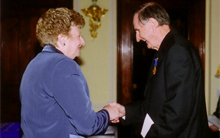  |
Brian Barry’s humble nature in his pursuit of excellence as a winemaker has seen his efforts and contributions to the Australian Wine Industry sometimes ignored, sometimes disregarded, and made a rod for his back, as this was often not appreciated by some members of the wine industry, who may have been motivated by jealousy or a fear of competition. |
From Brian’s start as a winemaker 1949, he has in the ensuing years stamped his authority on the tremendous range of Australian wine styles which stemmed from his pioneering methods in relation to table wine manufacture, which in latter years have become a wine industry standard. Many of these methods are now considered to be an every day practice for winemakers who endeavour to make the highest possible quality wine.
Brian was appointed by his industry peers to be chairman of judges at nearly all major Australian wine shows during the 1970’s and 1980’s, specifically due to the fact that he was considered to be the finest wine maker in Australia. During Brian’s time as chairman of judges, he had the extremely difficult task of improving the quality of Australian wines, as many entries had major winemaking faults.
He did this by being blunt with his wine show judging. Something that was very hard to do. Brian was highly critical, but fair in his wine judging. This upset many winemakers across the entire industry, many of whom were actually Brian’s friends. They did not like to be told that their wines were of sub standard. It can not be understated how difficult this was for Brian to receive such unfair criticism.
Brian’s critical approach to wine show judging encouraged and focused Australian winemakers to very carefully consider their winemaking methods. This created a surge of technological advances in Australian winemaking which would provide the winemakers a chance to earn medals on the show circuit, according to the nose, palate and consideration of Chairman Brian Barry’s leadership. This has brought our range of Australian wines in 2004 to the stage where they are considered to be equal to the finest in the world.
This in turn made the Australian Wine Export Boom possible through the 1980’s and 1990’s. This created thousands of jobs and of course attracted huge export revenue for Australia.
It should be recognised that without Brian Barry’s huge influence towards improving Australian wine quality, the Australian Wine Export Market boom may never have achieved or reached the levels that exist in 2004.
 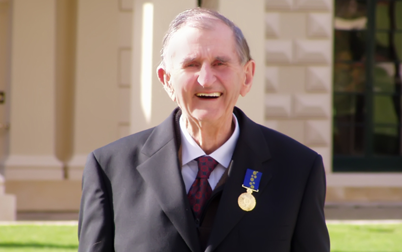 |
Brian Barry has won many of the highest winemaking awards over the years during his time at Berri Cooperative Winery and Distillery Ltd, the Stanley Wine Company, as consultant to various wine companies, and with his range of Jud’s Hill wines.
|
|

